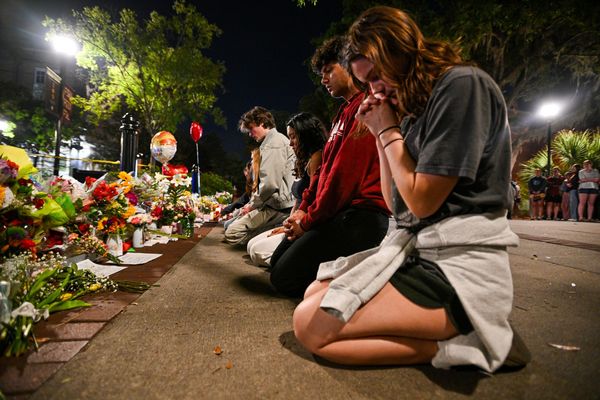
It isn’t just parents who watch over the kids playing at Harrison Park in Pilsen.
They also have the watchful eyes on them of the Aztec god Xōchipilli, looking on from a towering mural painted across the street at 1758 W. 19th St. by the artist known as SENKOE.
In Aztec mythology, Xōchipilli is the god of love, summer, flowers, dancing and various festivities.
Given the chance to paint a mural on a wall next to the park, SENKOE says he decided to paint Xōchipilli and portray the figure in his youth because he thought kids could relate to that.
In the Nahuatl language of the Aztec and Toltec peoples indigenous to what’s now Mexico — still spoken by some — Xōchipilli means “prince of the flowers,” combining the words xōchitl, for flower, and pilli, for prince or child. He filled the mural, completed in October 2020, with images of vibrant flowers surrounding the figure.
SENKOE says he painted Xōchipilli based on an ancient stone statue of the deity seated on a stone tablet and added hummingbirds, another symbol from Mexican culture.
“They represent messengers,” SENKOE says, speaking in Spanish, and are “also symbolic to another pre-Hispanic god, Huitzilopochtli.”
/cdn.vox-cdn.com/uploads/chorus_asset/file/22555545/xochipilli2.jpg)
Huitzilopochtli was the sun and war god of the Aztecs, one of two key deities, often represented as an eagle or hummingbird. It also was believed that dead warriors would be reincarnated as hummingbirds.
SENKOE says he has always liked to use such ancient references when creating his Mexican-inspired art, to “dig a little deeper” into his roots.
In the mural, Xōchipilli is seated amongst mushroom-like plants, representing the spiritual and medical uses of hallucinogenic plants.
The artist’s signature style, marked by brilliant hues, is reflective of traditional Mexican artwork.
SENKOE, a native of Mexico City, worked on this mural, as he often does, with his manager and fellow artist Valentina Pinci, 26. They met about three years ago in Playa del Carmen, Mexico, where they live, though they are frequent visitors to Chicago.
Pinci says she usually works “nearly 50/50” on murals with SENKOE, but this one was about 90% his work. Pinci, known as mandalaera on Instagram, says all she did on the Xōchipilli mural was work on detailing at the bottom.
The mural didn’t take long. Coming up with the concept preparing the wall and completing the painting all took about five days.
/cdn.vox-cdn.com/uploads/chorus_asset/file/22556281/xochipilli3__2_.jpg)
The job required a couple of hundred spray cans and a few gallons of paint. To get up that high on the wall, SENKOE rented a cherry picker.
SENKOE says he liked that the location is in Pilsen and close to the National Museum of Mexican Art.
“I feel people really appreciate this kind of bringing back these old stories to our modern day because I feel people have been disconnected from their identity and from their roots,” says SENKOE, whose work with art dates to his childhood and graffiti. “Through my art, they are able to then reconnect with what otherwise would be lost.”
SENKOE says he sees himself as multicultural, including the Aztecs and other ancient cultures. He says rediscovering their stories helps people “reform what it is to be Mexican.”







